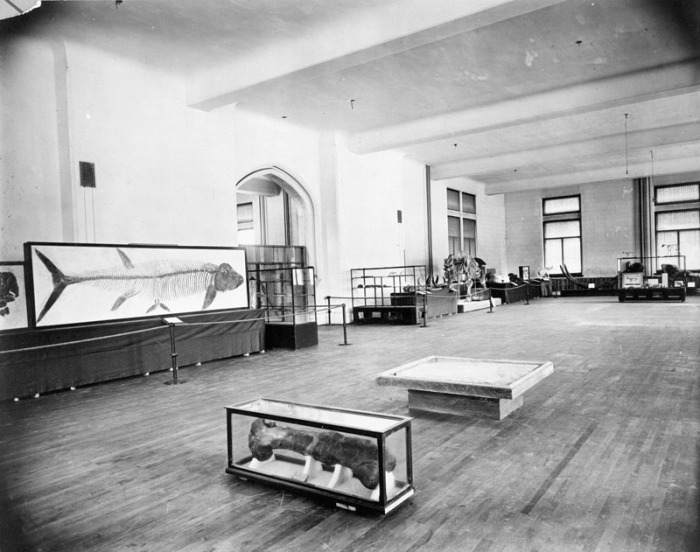Lately I’ve been looking through newspaper clippings to try to find anything I can about the national museums of Canada. In one of my online expeditions, I came across a clipping titled: “Keenly Interested in Fish Culture: Children So Numerous Lecture Given Twice.” Yes, you read that correctly.
Published on February 28, 1927, the article explained that the museum hosted a lecture by J. A. Rodd, who spoke about the methods that the Canadian government used to preserve and maintain the fisheries to hundreds of children. The lecture was so well attended that the lecture was going to be offered a second time.

Another lecture featured in the Ottawa Journal concerned Canada’s international role as an oil producer:

These lectures were not limited to audiences of children. Another article described a lecture given by Clyde Patch about the gannets of Bonaventure to the Ottawa Women’s Club:

In addition to lectures, the museum hosted conversaziones. These are essentially seminars or conversations based around topics of art and culture. It seems that these events were very popular because, as one article pointed out, “…[I]t enables many to view the different exhibits under such favorable circumstances and to enjoy the social side of the affair at the same time.” (1)
These conversaziones were not just intellectual events, but social too. In the previously cited article, for example, the outfit of Mrs. Jane Russell Stewart, wife of the Minister of Mines, was described in great detail. This particular conversazione was organized and hosted by the Professional Institute of the Civil Service of Canada and the Minster of Mines. The article listed all of the who’s who that participated in the event, but it also listed the key staff of the museum who had designed and built the exhibits that were on display.

In another article featuring the same event, each of the exhibits on display were described, and it was noted which ones were of particular interest to guests:
“The third exhibit, and one at which many of the guests were inclined to linger, consisted of specimens of palaeontology and palaeo-botany, arranged by the Geogical Survey, Department of Mines, showing the re-arranged skeletons of tremendous and peculiar animals of bygone age.” (2)

In addition to describing the exhibits on display, the article also listed all of the staff at the museum and what aspects of the exhibits they were responsible for. Hosting these events was not only an intellectual evening of palm-greasing and frivolity; it was also an opportunity for the museum to show its collection and hard work, as well as its worth as an institution:
“An exhibit which created perhaps more interest than any other was the splendid collection of vertebrate fossils arranged by the Geological Survey, Department of Mines, on the fourth floor, many of the specimens having been placed on exhibition specially for the occasion.” (3)

These events allowed the museum to put on display the government and private dollars that made the expeditions, research, and exhibitions possible. At this point in time, the museum was actually a branch of the Department of Mines (4). Opening up the museum as both an intellectual and social space helped to indicate that the museum was a versatile space that offered something more than just artifacts on dusty shelves. It could be social and fun, a large space where middle-class civil servants could dance and hob-nob on an evening out, as well as a space to send their kids for a few hours on the weekend that was educational and safe.

The fact that the articles also indicated which government department was responsible for which aspect of the work on display in the museum, coupled with the event being hosted by the Minister of Mines was an example of a government department showing exactly where its money and resources were going and how it was being used. Not only was this being shown to the civil servants attending and enjoying the event, but to every reader of the articles published about the coversaziones and the regular lectures in The Ottawa Journal.
The conversaziones and the lectures are also an indication that, while the practice of exhibition and the expectations for the role that museums played in society was quite different, by the late 20s, it was clearly not enough to simply display specimens behind glass. Speaking for myself only, learning about these two public events certainly made me re-evaluate my perception of museums as a public space in this period. For me, these articles show that, while the role of museums certainly was quite different, it was actually not as far off from today as you would think.
Footnotes:
- The Ottawa Journal, “Enjoyable Dance at the Museum, March 24, 1927, page 8.
- The Ottawa Journal, “Hundreds View Many Specimens at the Museum: Annual Conversazione Provides Opportunity to Inspect Exhibits Natural Resources,” March 24, 1927, page 13.
- Ibid.
- Loris S. Russell, The National Museum of Canada, 1910 to 1960, Ottawa: Department of Northern Affairs and National Resources (1961), 5.
Reblogged this on Christopher Ryan.
LikeLike